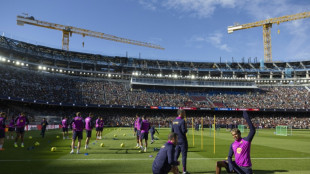
-
 EU defends carbon tax as ministers take over COP30 negotiations
EU defends carbon tax as ministers take over COP30 negotiations
-
McCartney to release silent AI protest song

-
 Stocks tepid on uncertainty over earnings, tech rally, US rates
Stocks tepid on uncertainty over earnings, tech rally, US rates
-
Louvre shuts gallery over ceiling safety fears

-
 'Stranded, stressed' giraffes in Kenya relocated as habitats encroached
'Stranded, stressed' giraffes in Kenya relocated as habitats encroached
-
US Supreme Court to hear migrant asylum claim case

-
 Western aid cuts could cause 22.6 million deaths, researchers say
Western aid cuts could cause 22.6 million deaths, researchers say
-
Clarke hails Scotland 'legends' ahead of crunch World Cup qualifier

-
 S.Africa says 'suspicious' flights from Israel show 'agenda to cleanse Palestinians'
S.Africa says 'suspicious' flights from Israel show 'agenda to cleanse Palestinians'
-
South Korea pledges to phase out coal plants at COP30

-
 Ex-PSG footballer Hamraoui claims 3.5m euros damages against club
Ex-PSG footballer Hamraoui claims 3.5m euros damages against club
-
Mbappe, PSG in counterclaims worth hundreds of millions

-
 Two newly discovered Bach organ works unveiled in Germany
Two newly discovered Bach organ works unveiled in Germany
-
Stocks lower on uncertainty over earnings, tech rally, US rates

-
 Barca to make long-awaited Camp Nou return on November 22
Barca to make long-awaited Camp Nou return on November 22
-
COP30 talks enter homestretch with UN warning against 'stonewalling'

-
 France makes 'historic' accord to sell Ukraine 100 warplanes
France makes 'historic' accord to sell Ukraine 100 warplanes
-
Delhi car bombing accused appears in Indian court, another suspect held

-
 Emirates orders 65 more Boeing 777X planes despite delays
Emirates orders 65 more Boeing 777X planes despite delays
-
Ex-champion Joshua to fight YouTube star Jake Paul

-
 Bangladesh court sentences ex-PM to be hanged for crimes against humanity
Bangladesh court sentences ex-PM to be hanged for crimes against humanity
-
Trade tensions force EU to cut 2026 eurozone growth forecast

-
 'Killed without knowing why': Sudanese exiles relive Darfur's past
'Killed without knowing why': Sudanese exiles relive Darfur's past
-
Stocks lower on uncertainty over tech rally, US rates

-
 Death toll from Indonesia landslides rises to 18
Death toll from Indonesia landslides rises to 18
-
Macron, Zelensky sign accord for Ukraine to buy French fighter jets

-
 India Delhi car bomb accused appears in court
India Delhi car bomb accused appears in court
-
Bangladesh ex-PM sentenced to be hanged for crimes against humanity

-
 Leftist, far-right candidates advance to Chilean presidential run-off
Leftist, far-right candidates advance to Chilean presidential run-off
-
Bangladesh's Hasina: from PM to crimes against humanity convict

-
 Rugby chiefs unveil 'watershed' Nations Championship
Rugby chiefs unveil 'watershed' Nations Championship
-
EU predicts less eurozone 2026 growth due to trade tensions

-
 Swiss growth suffered from US tariffs in Q3: data
Swiss growth suffered from US tariffs in Q3: data
-
Bangladesh ex-PM sentenced to death for crimes against humanity

-
 Singapore jails 'attention seeking' Australian over Ariana Grande incident
Singapore jails 'attention seeking' Australian over Ariana Grande incident
-
Tom Cruise receives honorary Oscar for illustrious career

-
 Fury in China over Japan PM's Taiwan comments
Fury in China over Japan PM's Taiwan comments
-
Carbon capture promoters turn up in numbers at COP30: NGO

-
 Japan-China spat over Taiwan comments sinks tourism stocks
Japan-China spat over Taiwan comments sinks tourism stocks
-
No Wemby, no Castle, no problem as NBA Spurs rip Kings

-
 In reversal, Trump supports House vote to release Epstein files
In reversal, Trump supports House vote to release Epstein files
-
Gauff-led holders USA to face Spain, Argentina at United Cup

-
 Ecuador voters reject return of US military bases
Ecuador voters reject return of US military bases
-
Bodyline and Bradman to Botham and Stokes: five great Ashes series

-
 Iran girls kick down social barriers with karate
Iran girls kick down social barriers with karate
-
Asian markets struggle as fears build over tech rally, US rates

-
 Australia's 'Dad's Army' ready to show experience counts in Ashes
Australia's 'Dad's Army' ready to show experience counts in Ashes
-
UN Security Council set to vote on international force for Gaza

-
 Japan-China spat sinks tourism stocks
Japan-China spat sinks tourism stocks
-
Ecuador voters set to reject return of US military bases


SpaceX mega rocket lost in final phase of 'successful' test flight
Starship, the world's most powerful rocket, flew further and faster than ever before during its third test flight Thursday, although it was eventually lost as it re-entered the atmosphere over the Indian Ocean, SpaceX said.
Lift-off from the company's Starbase in Boca Chica, Texas came around 8:25 am local time (1325 GMT) and was carried live on a webcast that was watched by millions on social media platform X.
The sleek mega rocket is vital to NASA's plans for landing astronauts on the Moon later this decade -- and Elon Musk's hopes of colonizing Mars some day.
"Congrats to @SpaceX on a successful test flight!" tweeted NASA administrator Bill Nelson following the test.
All eyes were on Thursday's launch after two prior attempts ended in spectacular explosions. But that's not necessarily a bad thing: The company has adopted a rapid trial-and-error approach in order to accelerate development, and the strategy has brought it numerous successes in the past.
- Objectives met -
When the two stages of Starship are combined, the rocket stands 397 feet (121 meters) tall -- beating the Statue of Liberty by a comfortable 90 feet.
Its Super Heavy Booster produces 16.7 million pounds (74.3 Meganewtons) of thrust, almost double that of the world's second most powerful rocket, NASA's Space Launch System -- though the latter is now certified, while Starship is still a prototype.
Starship's third launch test in its fully stacked configuration was its most ambitious yet and the company said it was able to meet many of its objectives.
These included opening and closing Starship's payload door to test its ability to deliver satellites into orbit.
High definition footage from an onboard camera showed Starship coasting in space, with the curve of the Earth visible in the background. It hit a top speed of more than 26,000 kilometers per hour (16,000 mph) and achieved an altitude of more than 200 kilometers above sea level.
Starship flew halfway around the globe, then began its descent over the Indian Ocean, with engineers cheering as its heat shield composed of 18,000 hexagonal tiles glowed red hot.
But ground control stopped receiving signals and announcers declared the vessel "lost" before it could achieve its final goal of splashing down. The lower-stage booster also failed to make a successful water landing, and as a result, the Federal Aviation Administration said it was opening a "mishap" investigation.
"Starship will make life multiplanetary," Musk, the company's billionaire founder, posted on X afterward, emphasizing the progress made.
- Real world testing -
The first so-called "integrated" test came in April 2023. SpaceX was forced to blow up Starship within a few minutes of launch, because the two stages failed to separate.
The rocket disintegrated into a ball of fire and crashed into the Gulf of Mexico, sending a dust cloud over a town several miles (kilometers) away.
The second test in November 2023 fared slightly better: The booster separated from the spaceship, but both then exploded over the ocean, in what the company euphemistically called a "rapid unscheduled disassembly."
It currently costs SpaceX around $90 million to build each Starship, according to a report by the research company Payload published in January.
SpaceX's strategy of carrying out tests in the real world rather than in labs has paid off in the past.
Its Falcon 9 rockets have come to be workhorses for NASA and the commercial sector, its Dragon capsule sends astronauts and cargo to the International Space Station, and its Starlink internet satellite constellation now covers dozens of countries.
But the clock is ticking for SpaceX to be ready for NASA's planned return of astronauts to the Moon in 2026, using a modified Starship as the lander vehicle.
China is approaching in the rear view mirror, targeting 2030 to land its first crew on the Moon.
Not only does SpaceX need to prove it can launch, fly and land Starship safely -- it must eventually also show it can send multiple "Starship tankers" into orbit to refuel, at supercooled temperatures, a main Starship for its onward journey to the Moon.
A.Suleiman--SF-PST




